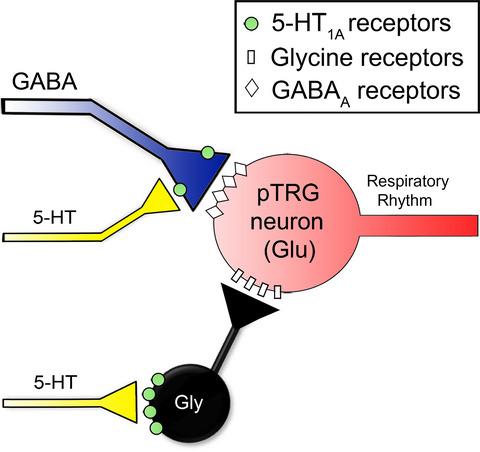当前位置:
X-MOL 学术
›
Eur. J. Neurosci.
›
论文详情
Our official English website, www.x-mol.net, welcomes your
feedback! (Note: you will need to create a separate account there.)
Key role of 5-HT1A receptors in the modulation of the neuronal network underlying the respiratory rhythm generation in lampreys.
European Journal of Neuroscience ( IF 2.7 ) Pub Date : 2020-05-07 , DOI: 10.1111/ejn.14769 Elenia Cinelli 1 , Donatella Mutolo 1 , Ludovica Iovino 1 , Tito Pantaleo 1 , Fulvia Bongianni 1
European Journal of Neuroscience ( IF 2.7 ) Pub Date : 2020-05-07 , DOI: 10.1111/ejn.14769 Elenia Cinelli 1 , Donatella Mutolo 1 , Ludovica Iovino 1 , Tito Pantaleo 1 , Fulvia Bongianni 1
Affiliation

|
In mammals, 5‐HTexcitatory respiratory effects imply 5‐HT1A receptor‐mediated disinhibition of pre‐Bötzinger complex neurons. In the lamprey, 5‐HT1A receptors are involved in the neural control of locomotion, but their role in the respiratory regulation, particularly at the level of the putative respiratory rhythm generator, the paratrigeminal respiratory group (pTRG), is not known. We here investigate the respiratory function of inhibitory 5‐HT1A receptors within the pTRG of the isolated brainstem of the adult lamprey. The 5‐HT1A receptor agonists either bath applied or microinjected into the pTRG did not cause significant effects. However, the selective 5‐HT1A receptor antagonist (S)‐WAY 100135 bath applied or microinjected into the pTRG induced depressing respiratory effects or even apnoea, thus revealing that 5‐HT exerts a 5‐HT1A receptor‐mediated potent tonic influence on respiration and contributes to maintain baseline levels of respiratory activity. Microinjections of strychnine or bicuculline, either alone or in combination, into the pTRG prevented (S)‐WAY 100135‐induced apnoea. In addition, immunohistochemical studies corroborate the present findings suggesting that 5‐HT1A receptors are widely expressed in close apposition to the soma of glycine‐immunoreactive cells located within the pTRG region. The results show that in the lamprey respiratory network, 5‐HT exerts a tonic influence on respiration by a potent inhibitory control on both GABAergic and glycinergic mechanisms. The observed disinhibitory effects resemble the excitatory respiratory modulation exerted by 5‐HT1A receptor‐mediated inhibition of glycinergic and/or GABAergic neurons present in mammals, supporting the notion that some features of the neuronal network subserving respiratory rhythm generation are highly conserved throughout phylogeny.
中文翻译:

5-HT1A受体在七lamp鳗呼吸节律产生背后的神经元网络调节中的关键作用。
在哺乳动物中,5-HT兴奋性呼吸作用暗示了5-HT 1A受体介导的博茨欣前复合神经元抑制作用。在七lamp鳗中,5-HT 1A受体参与运动的神经控制,但尚不清楚它们在呼吸调节中的作用,特别是在假定的呼吸节律产生器,三叉神经上呼吸道组(pTRG)的水平上。我们在这里研究成年七lamp鳗的孤立脑干的pTRG中抑制性5‐HT 1A受体的呼吸功能。将5‐HT 1A受体激动剂浸入浴液中或微注射到pTRG中均不会产生明显影响。但是,选择性5-HT 1A受体拮抗剂(S)-WAY 100135浴液应用或显微注射入pTRG会导致呼吸抑制甚至呼吸暂停,从而揭示5-HT对呼吸作用具有5-HT 1A受体介导的强力滋补作用,并有助于维持基线水平呼吸活动。将士的宁或双瓜氨酸单独或联合微量注射到pTRG中可预防(S)-WAY 100135引起的呼吸暂停。此外,免疫组化研究证实了目前的发现,表明5-HT 1A受体在pTRG区域内与甘氨酸免疫反应性细胞的体质紧密相关并广泛表达。结果表明,在七rey鳗的呼吸网络中,5-HT通过有效抑制GABA能和甘氨酸能机制来对呼吸作用产生强直作用。观察到的抑制作用类似于由5-HT 1A受体介导的对哺乳动物中的甘氨酸能和/或GABA能神经元的抑制所产生的兴奋性呼吸调节作用,这支持了在整个系统发育过程中高度保护呼吸节律的神经元网络的某些特征得到保护的观点。
更新日期:2020-05-07
中文翻译:

5-HT1A受体在七lamp鳗呼吸节律产生背后的神经元网络调节中的关键作用。
在哺乳动物中,5-HT兴奋性呼吸作用暗示了5-HT 1A受体介导的博茨欣前复合神经元抑制作用。在七lamp鳗中,5-HT 1A受体参与运动的神经控制,但尚不清楚它们在呼吸调节中的作用,特别是在假定的呼吸节律产生器,三叉神经上呼吸道组(pTRG)的水平上。我们在这里研究成年七lamp鳗的孤立脑干的pTRG中抑制性5‐HT 1A受体的呼吸功能。将5‐HT 1A受体激动剂浸入浴液中或微注射到pTRG中均不会产生明显影响。但是,选择性5-HT 1A受体拮抗剂(S)-WAY 100135浴液应用或显微注射入pTRG会导致呼吸抑制甚至呼吸暂停,从而揭示5-HT对呼吸作用具有5-HT 1A受体介导的强力滋补作用,并有助于维持基线水平呼吸活动。将士的宁或双瓜氨酸单独或联合微量注射到pTRG中可预防(S)-WAY 100135引起的呼吸暂停。此外,免疫组化研究证实了目前的发现,表明5-HT 1A受体在pTRG区域内与甘氨酸免疫反应性细胞的体质紧密相关并广泛表达。结果表明,在七rey鳗的呼吸网络中,5-HT通过有效抑制GABA能和甘氨酸能机制来对呼吸作用产生强直作用。观察到的抑制作用类似于由5-HT 1A受体介导的对哺乳动物中的甘氨酸能和/或GABA能神经元的抑制所产生的兴奋性呼吸调节作用,这支持了在整个系统发育过程中高度保护呼吸节律的神经元网络的某些特征得到保护的观点。











































 京公网安备 11010802027423号
京公网安备 11010802027423号